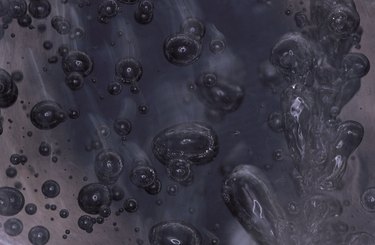
The elodea is an aquatic perennial plant. When in bloom, elodea produces white, three-petaled flowers that float on the surface of the water. Elodea produces bubbles when it breathes. This trait makes the elodea a useful tool in the study of plant structures and plants' ability to produce energy.
Photosynthesis
Video of the Day
The bubbles that you see rising from the leaves of an elodea cutting are actually a byproduct of a process known as photosynthesis. Photosynthesis occurs in plants and some forms of algae. The process converts light energy into a type of chemical energy stored as sugar. Chlorophyll and beta-carotene play a large role in this conversion. For most plants, this process takes place in the leaves with minor amounts of photosynthesis occurring in the stems.
Video of the Day
Cellular Structure
The cellular structure of the elodea plant makes it an ideal candidate for oxygen experiments. Freshly cut elodea floating in water produce the most observable bubbles. As photosynthesis occurs, elodea plants pass the produced oxygen from leaves to stem. Some oxygen escapes from the leaves to form oxygen bubbles in the water but the majority escapes from the stem as a result of larger intracellular air spaces. The intracellular air spaces of the stem are less compact than the leaves, which explain this phenomenon.
Aerenchyma
The term used to describe larger-sized intracellular air spaces such as those found in elodea is aerenchyma. Aerenchyma provides aquatic plants with the means to transport light-converted oxygen to their roots. This effective intracellular design also allows carbon dioxide to rise from the roots to the stem and leaves of the elodea for efficient utilization. A plant that is rapidly undergoing photosynthesis tends to develop a build-up of oxygen gas in the aerenchyma. The result is a burst of bubbles after releasing the gas.
Observable Bubbles
The number of observable bubbles produced by elodea can help determine the rate of photosynthesis. However, the oxygen bubbles produced are only an approximate measurement. Since oxygen is capable of dissolving in water, not all will transform to gas and appear in the form of bubbles. The type of light used for photosynthesis also determines the amount of oxygen bubbles produced -- the more heat that exudes from the light source, the warmer the water. The higher the water temperatures rise, the less likely oxygen is to dissolve. The result of this scenario is more oxygen bubbles produced.